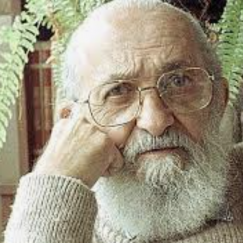The opportunistic teacher who embraces the leisure interests of his pupils in the hope of leading them to higher things is as frequently unsympathetic to the really valuable qualities of popular culture as his colleague who remains resolutely hostile. A true training in discrimination is concerned with pleasure.
Bio/Short Description
George Herbert Mead was an American sociologist who was part of what we now call the Chicago School, a group of scholars including John Dewey and Charles Cooley who studied communication, education, human development, and democracy at the turn of the 20th century. They were pioneers in the academic study of communication and media. The Chicago School scholars “gave voice to the idea that media and communication have a central role to play in shaping individual and collective lives, and in cementing identities and communities.” To understand society, we must first understand “how we communicate with each other and how the media shape our social bonds and social worlds."
In communication scholarship, Mead is considered the founder of the theory of symbolic interactionism, which positions communication as the sharing of meaning through language and symbols. This theory positions people as actively shaping the social world, in effect “creating their reality” through social interactions. Mead’s ideas include:
- People’s sense of personal identity emerges from their social interactions. During childhood and throughout life, how people treat you gradually shapes how you see yourself. In his book Mind, Self and Society, Mead describes how the individual mind and self arise out of the social process of interacting with others. Through first gestures and then language, humans gain a sense of self as they engage socially. Instead of approaching human experience in terms of individual psychology, Mead analyzes human identity and experience from the standpoint of communication as essential to the social order. By claiming that individual identity is socially constructed, he views the development of self-awareness as also driven by social processes. During adolescence, people come to care about the perceptions of others, including parents, teachers, and peers. Mead’s colleague Charles Cooley called this identity process “the looking glass self." We learn about ourselves through our interpretation of how others react to us.
- By understanding and manipulating symbols that circulate within a culture, individuals come to understand and empathize with others. In examining human development, Mead noticed that children are self-centered and cannot take the perspective of another. Gradually, through imitation and play, they take on the attitudes of the people around them, especially parents, caregivers, and siblings. Through play, children practice using symbols and communication and then experience situations that create a sense of belonging. Pretend play enables children to mentally assume the perspectives of another person. Over time, children acquire a deeper sense of being part of a group, and by adolescence, they become “capable of holding membership in different groups, both simultaneously and serially." Young adults gradually comes to view themselves as members of a nation, a profession, or an occupational group and for each group they participate in, they develop a sense of identity in relation to the generalized others. This is how children acquire a sense of themselves as a member of a community.
- Human relationships are fundamentally situational and multiperspectival. Mead believes that an individual’s perspective is shaped in relation to a particular situation or environment, but he does not see different human perspectives as imperfect representations of some absolute reality. He does not see that some people’s interpretations are flawed, distorted, or inadequate. On the contrary, “these situations are the reality” that is the world Because the self is socially constructed, Mead sees socialization as enabling the full potential of human freedom. Mead believes that there is “no absolute limit to the individual’s capacity to encompass new others within the dynamic structure of the self." Fundamentally, human freedom is enabled through the choices we make in our social relationships and interactions with others.
HOW THEY INFLUENCED YOU?
Other Grandparents
 ColinPosted By: Renee HobbsOn:07/13/2025 - 00:50
ColinPosted By: Renee HobbsOn:07/13/2025 - 00:50
 Seymour Posted By: Renee HobbsOn:03/14/2022 - 21:09
Seymour Posted By: Renee HobbsOn:03/14/2022 - 21:09
 PaoloPosted By: Renee HobbsOn:07/22/2021 - 16:11
PaoloPosted By: Renee HobbsOn:07/22/2021 - 16:11
 DonnaPosted By: Renee HobbsOn:03/22/2021 - 00:57
DonnaPosted By: Renee HobbsOn:03/22/2021 - 00:57
 Albert Posted By: Renee HobbsOn:11/27/2020 - 22:15
Albert Posted By: Renee HobbsOn:11/27/2020 - 22:15



